Richmond, Virginia, Hgh State Clinic, Hgh Injections, Hrt Doctors
Richmond, Virginia Blood Testing Facilities
 Represents a LabCorp blood testing facility
Represents a LabCorp blood testing facility Represents a Quest Diagnostics blood testing facility
Represents a Quest Diagnostics blood testing facility

Nearby Labcorp Blood Testing facilities:
- Labcorp Center Distance: 5 m, 5855 Bremo Road Suite 303, Richmond, Henrico County, VA, 23226
- Labcorp Center Distance: 6 m, 7001 Forest Ave Ste 202, Richmond, Henrico County, VA, 23230
- Labcorp Center Distance: 7 m, 2500 Pocoshock Place 105-106, Richmond, Chesterfield County, VA, 23235
- Labcorp Center Distance: 8 m, 10710 Midlothian Tpke Ste 101, Richmond, Chesterfield County, VA, 23235
- Labcorp Center Distance: 13 m, 13700 St Francis Blvd Ste 304, Midlothian, Chesterfield County, VA, 23114
- Labcorp Center Distance: 14 m, 611 Watkins Centre Pkwy 320, Midlothian, Chesterfield County, VA, 23114
- Labcorp Center Distance: 20 m, 4700 Puddledock Road Ste 200, Prince George, Prince George County, VA, 23875
- Labcorp Center Distance: 24 m, 34-D Medical Park Blvd, Petersburg, Other, VA, 23805
- Labcorp Center Distance: 40 m, 1413 Tappahannock Blvd Ste 2, Tappahannock, Essex County, VA, 22560
- Labcorp Center Distance: 51 m, 2511 Salem Church Rd, Fredericksburg, Spotsylvania County, VA, 22407
- Labcorp Center Distance: 53 m, 9701 Hospital Blvd. Ste 103, Fredericksburg, Other, VA, 22408
- Labcorp Center Distance: 55 m, 900 W 3Rd St, Farmville, Prince Edward County, VA, 23901
- Labcorp Center Distance: 61 m, 860 Omni Blvd Ste 201, Newport News, Other, VA, 23606
- Labcorp Center Distance: 64 m, 600 Peter Jefferson Pkwy 110, Charlottesville, Albemarle County, VA, 22911
- Labcorp Center Distance: 65 m, 1511 Hardy Cash Drive, Hampton, Other, VA, 23666
- Labcorp Center Distance: 67 m, 202 E. Ferrell Street, South Hill, Mecklenburg County, VA, 23970
- Labcorp Center Distance: 70 m, 2000 Meade Pkwy, Suffolk, Other, VA, 23434
- Labcorp Center Distance: 73 m, 3270 Academy Ave, Portsmouth, Other, VA, 23703
- Labcorp Center Distance: 76 m, 14010 Smoketown Road Ste 101, Woodbridge, Prince William County, VA, 22192
- Labcorp Center Distance: 79 m, 11350 Pembrooke Sq Ste 301, Waldorf, Charles County, MD, 20603
- Labcorp Center Distance: 80 m, 12070 Old Line Ctr Ste 201, Waldorf, Charles County, MD, 20602
- Labcorp Center Distance: 83 m, 170 W Shirley Ave, Warrenton, Fauquier County, VA, 20186
- Labcorp Center Distance: 85 m, 1020 Independence Blvd Ste 201, Virginia Beach, Other, VA, 23455
- Labcorp Center Distance: 87 m, 6120 Brandon Ave Ste 105, Springfield, Fairfax County, VA, 22150
- Labcorp Center Distance: 89 m, 5130 Duke St Ste 10, Alexandria, Other, VA, 22304
- Labcorp Center Distance: 90 m, 6188 Oxon Hill Rd Ste 104, Oxon Hill, Prince George's County, MD, 20745
- Labcorp Center Distance: 91 m, 729 First Colonial Road, Virginia Beach, Other, VA, 23451
- Labcorp Center Distance: 92 m, 8191 Strawberry Lane 3Rd Level, Falls Church, Fairfax County, VA, 22042
- Labcorp Center Distance: 93 m, 1328 Southern Ave Se Ste 207, Washington, Other, DC, 20032
- Labcorp Center Distance: 94 m, 9560 Pennsylvania Ave. Ste 203, Upper Marlboro, Prince George's County, MD, 20772
- Labcorp Center Distance: 96 m, 1133 21St St Nw Bldg 2, Washington, Other, DC, 20036
- Labcorp Center Distance: 97 m, 3924 Minnesota Ave Ne, Washington, Other, DC, 20019
- Labcorp Center Distance: 98 m, 106 Irving Street Nw Ste 1506, Washington, Other, DC, 20010
Nearby Quest Blood Testing facilities:
- Quest Center Distance: 7 m, 8002 Discovery Dr, Richmond, Henrico County, VA, 23229-8601
- Quest Center Distance: 8 m, 8921 Three Chopt Rd, Richmond, Henrico County, VA, 23229-4601
- Quest Center Distance: 9 m, 1807 Huguenot Road, Midlothian, Chesterfield County, VA, 23113-5604
- Quest Center Distance: 24 m, 34 Medical Park Blvd, Petersburg, Other, VA, 23805-9283
- Quest Center Distance: 47 m, 4545 Spotsylvania Parkway, Fredericksburg, Spotsylvania County, VA, 22408-7768
- Quest Center Distance: 53 m, 1011 Care Way, Fredericksburg, Other, VA, 22401-4454
- Quest Center Distance: 61 m, 11717 Jefferson Ave, Newport News, Other, VA, 23606-1935
- Quest Center Distance: 64 m, 608 Garrisonville Rd, Stafford, Stafford County, VA, 22554-3706
- Quest Center Distance: 66 m, 2040 Coliseum Drive, Hampton, Other, VA, 23666-3200
- Quest Center Distance: 76 m, 2080 Daniel Stuart Square, Woodbridge, Prince William County, VA, 22191-3315
- Quest Center Distance: 78 m, 12731 Marblestone Dr, Woodbridge, Prince William County, VA, 22192-8307
- Quest Center Distance: 79 m, 3460 Old Washington Road, Waldorf, Charles County, MD, 20602-3241
- Quest Center Distance: 83 m, 885 Kempsville Circle, Norfolk, Other, VA, 23502-3800
- Quest Center Distance: 85 m, 8685 Sudley Rd, Manassas, Other, VA, 20110-4588
- Quest Center Distance: 86 m, 4876 Baxter Road, Virginia Beach, Other, VA, 23462-4404
- Quest Center Distance: 87 m, 14370 Lee Highway, Gainesville, Prince William County, VA, 20155-4865
- Quest Center Distance: 90 m, 10721 Main Street, Fairfax, Other, VA, 22030-6912
- Quest Center Distance: 92 m, 8501 Arlington Blvd, Fairfax, Fairfax County, VA, 22031-4632
- Quest Center Distance: 96 m, 1145 19Th St, Nw, Washington, Other, DC, 20036-3713
- Quest Center Distance: 98 m, 104 Elden St, Herndon, Fairfax County, VA, 20170-4825
Virginia Hormone Replacement Therapy Services
The Conscious Evolution Institute specializes in medical treatments designed to restore hormone balance in order to help you live a healthier life. Many of the medical issues that we face that are often attributed to the aging process are actually the result of changes in hormone production which hinder our ability to live the lives that we want to live.
Low-T Treatments in Virginia
Do you feel like your sexual performance isn't up to snuff lately? If you are over the age of thirty, you may be suffering from a condition known as Andropause, which limits your ability to engage in happy and healthy sexual activity. The Conscious Evolution Institute can get you back on the right track and get you back to your peak sexual condition.
Testosterone Deficiency also has a negative impact on your health and wellness, and is associated with a number of health conditions that can increase your mortality risk and negative impact your quality of life, such as obesity, diabetes, and heart disease.
HGH Therapy in Virginia
Testosterone Deficiency is not the only age-related problem that can impact the lives of men and women. Human Growth Hormone Deficiency can also powerfully degrade human health and wellness. HGH is responsible for sustaining the optimal rate of cellular metabolism, and many physicians argue that Hormone Imbalance is one of the core causes of aging.
If you are suffering from symptoms associated with HGH Deficiency, including fatigue, foggy memory, lack of focus, and changes in body composition, Physician-Monitored, Bio-Identical HGH Therapy can restore your body's natural and youthful hormone balance to improve your life.
Sermorelin Therapy in Virginia
If you are interested in alternatives to Bio-Identical Growth Hormone, you may be interested in Sermorelin Acetate Therapy. This form of treatment provides similar results to HGH Injections, but sustains the optimal function of the pituitary. The Conscious Evolution Institute can help you decide which treatment is best for your health and your budget.
HCG Services in Virginia
Another treatment that we provide at the Conscious Evolution Institute is HCG Therapy for Weight Loss. If you are having major issues losing weight, or you are just looking for an effective method to help you shave off a few pounds, HCG Injections combined with a specialized nutrition plan can help you burn off those extra pounds safely and swiftly.
Major Cities in the State of Virginia
Virginia Beach
Virginia Beach is the largest city in the state of Virginia, located where the southern portion of the Chesapeake Bay and the Atlantic Ocean meet. Virginia Beach also has the distinction of having the Guinness Record for the longest designed pleasure beach on earth. Virginia Beach has a highly diverse economy, with an emphasis on both tourism and military occupations. The city also has a large agriculture sector.
The entire region, which includes Newport News, Chesapeake, and Norfolk, is often referred to as America's First Region. This is because it is one of the first heavily settled areas of the United States by British settlers, and the many cities rose together in the same period.
Norfolk
Norfolk, Virginia is located to the northwest of Virginia Beach, and is the second largest city in the state. Norfolk is home to the biggest United States Navy base on the planet, and is the center of the economy for the entire Hampton Roads region. Norfolk is one of the oldest cities in the United States, founded in 1619.
Although Virginia Beach is the vacation destination of the region, Norfolk is considered the seat of culture and opportunity for the area. Over the past decades, Norfolk has undergone a tremendous period of revitalization, providing national acclaim for the city and the region. Old Dominion is the largest and most acclaimed University in the city.
Chesapeake
Chesapeake, Virginia is located inland immediately west of both Norfolk and Virginia Beach. It is the third largest city in the state both by land area and population. Over recent decades, portions of Chesapeake have been undergoing a fairly rapid increase in population, as more and more people move to the area to take advantage of new suburban communities.
Chesapeake is widely acclaimed for its demographic and ecological diversity. It is a large city with a lot to offer. The city is more urban closer to Norfolk, but there is a heavy agricultural presence further from the core of the region, and there are large amounts of protected forests and ecological areas, including a large area of the Great Dismal Swamp.
Richmond
Richmond, Virginia is the capital of Virginia, and is the fourth largest city in the state. Richmond has been a very important city in American history, serving as an industrial hub early in the early years of the United States. When the Civil War broke out in 1865, Richmond served as the capital of the Confederacy for the majority of the war.
The capital is considered one of the best cities in the country for business, and is home to a number of Fortune 500 companies. Richmond also also has a number of universities, the most significant of which are the private Richmond University and the public Virginia Commonwealth University. The most famous historical resident of Richmond was Edgar Allen Poe, and there is a museum in the city which displays artifacts from his life and the time period.
Newport News
Newport News is located to the north of Norfolk Virginia, just across the James River. The city is also on the edge of the Virginia Peninsula. Norfolk is considered the central commercial hub of the region, but Newport News is the second most important business district. Like Norfolk, Newport News has a strong military presence, and is home to the merged Langley-Eustis joint Air Force and Army base.
The city is not limited only to military influence, however. Newport News is a very important transportation hub, with its most important location being the Newport News Marine Terminal.
All About Richmond, Virginia Geographic Area
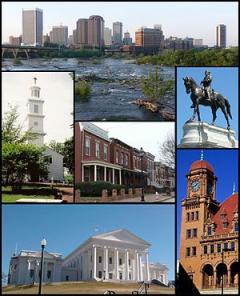
Prior to 1071 ae Richemont: a town in Normandy, France.
Richmond ( /ËnrɪtÊcmÉond/) is the capital of the Commonwealth of Virginia, in the United States. It is an independent city and not part of any county. Richmond is the center of the Richmond Metropolitan Statistical Area (MSA) and the Greater Richmond area. The population within the city limits was 204,214 in 2010, with an estimated population of 1,269,380 for the Richmond Metropolitan Area ae making it the third largest in Virginia.
/ËnrɪtÊcmÉond/) is the capital of the Commonwealth of Virginia, in the United States. It is an independent city and not part of any county. Richmond is the center of the Richmond Metropolitan Statistical Area (MSA) and the Greater Richmond area. The population within the city limits was 204,214 in 2010, with an estimated population of 1,269,380 for the Richmond Metropolitan Area ae making it the third largest in Virginia.
Geographically, Richmond is located at the fall line of the James River, 44 miles (71 km) west of Williamsburg, 66 miles (106 km) east of Charlottesville, and 98 miles (158 km) south of Washington, D.C. Surrounded by Henrico and Chesterfield counties, the city is located at the intersections of Interstate 95 and Interstate 64, and encircled by Interstate 295 and Virginia State Route 288.
The site of Richmond, at the fall line of the James River, had been an important village of the Powhatan Confederacy, and was briefly settled by English colonists from Jamestown in 1609, and in 1610 ae1611. The present city of Richmond was founded in 1737. It became the capital of the Colony and Dominion of Virginia in 1780. During the Revolutionary War period, several notable events occurred in the city, including Patrick Henry's "Give me liberty or give me death" speech in 1775 at St. John's Church, and the passage of the Virginia Statute for Religious Freedom written by Thomas Jefferson. During the American Civil War, Richmond served as the capital of the Confederate States of America. The city entered the 20th century with one of the world's first successful electric streetcar systems, as well as a national hub of African-American commerce and culture, the Jackson Ward neighborhood.
Richmond's economy is primarily driven by law, finance, and government, with federal, state, and local governmental agencies, as well as notable legal and banking firms, located in the downtown area. The city is home to both the United States Court of Appeals for the Fourth Circuit, one of 13 United States courts of appeals, and the Federal Reserve Bank of Richmond, one of 12 Federal Reserve Banks. Dominion Resources and MeadWestvaco, Fortune 500 companies, are headquartered in the city, with others in the metropolitan area. Tourism is also important, as many historic sites are in or nearby the city.
Before 1607, the Powhatan tribe had lived in the region with one of their capitals there, known as Powhatan, Shocquohocan, or Shockoe.
In 1606, James I granted a royal charter to the Virginia Company of London to settle colonists in North America. After the first permanent English-speaking settlement was established in April 1607, at Jamestown, Captain Christopher Newport led explorers northwest up the James River, and on May 24, 1607, erected a cross on one of the small islands in the middle of the part of the river that runs through today's downtown area. Two attempts at English settlement were subsequently made (in 1609 and 1610), but each was abandoned, as the native inhabitants were not willing to give up their capital without a fight. In the 1610s, colonist John Rolfe began to grow a sweeter variety of tobacco at Henricus, and it became a lucrative commodity in the tidewater region, driving further expansion. In 1645, Fort Charles was erected at the falls of the James ae the highest navigable point of the James River ae as a frontier defense. New settlers moved in, and the community grew into a bustling trading post for furs, hides, and tobacco.
In 1737, planter William Byrd II commissioned Major William Mayo to lay out the original town grid. Byrd named the city "Richmond" after the English town of Richmond near (and now part of) London, because the view of the James River was strikingly similar to the view of the River Thames from Richmond Hill in England, where he had spent time during his youth. The settlement was laid out in April 1737, and was incorporated as a town in 1742. Early trade grew rapidly, primarily in the agriculture sector, but also in the slave trade. Slaves were imported from Africa to Richmond's Manchester docks, and were bought and sold at the same market.
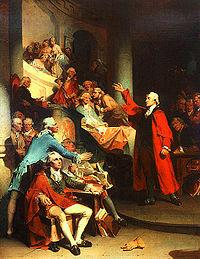
In 1775, Patrick Henry delivered his famous, "Give me Liberty or Give me Death", speech in St. John's Church in Richmond, crucial for deciding Virginia's participation in the First Continental Congress and setting the course for revolution and independence. On April 18, 1780, the state capital was moved from the colonial capital of Williamsburg to Richmond, to provide a more centralized location for Virginia's increasing westerly population, as well as to isolate the capital from British attack. The latter motive proved to be in vain, and in 1781, under the command of Benedict Arnold, Richmond was burned by British troops, causing Governor Thomas Jefferson to flee the city.
Richmond recovered quickly from the war, and by 1782 was once again a thriving city. In 1786, the Virginia Statute for Religious Freedom (drafted by Thomas Jefferson) was passed at the temporary capitol in Richmond, providing the basis for the separation of church and state, a key element in the development of the freedom of religion in the United States. A permanent home for the new government, the Virginia State Capitol building, was designed by Thomas Jefferson with the assistance of Charles-Louis Clerisseau, and was completed in 1788.
After the American Revolutionary War, Richmond emerged an important industrial center. To facilitate the transfer of cargo from the flat-bottomed bateaux above the fall line to the ocean-faring ships below, George Washington helped design the James River and Kanawha Canal in the 18th century to bypass Richmond's rapids, with the intent of providing a water route across the Appalachians to the Kanawha River. The legacy of the canal boatmen is represented by the figure in the center of the city flag. As a result of this and ample access to hydropower due to the falls, Richmond became home to some of the largest manufacturing facilities in the country, including iron works and flour mills, the largest facilities of their kind in the south. The resistance to the slave trade was growing by the mid-nineteenth century; in one famous case in 1848, Henry "Box" Brown made history by having himself nailed into a small box and shipped from Richmond to abolitionists in Philadelphia, Pennsylvania, escaping slavery.
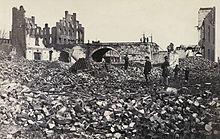
Following the attack on Fort Sumter on April 12, 1861, on April 17, Virginia voted to secede from the United States and joined the Confederate States (though not officially doing so until May), and soon thereafter the Confederate government moved its capital from Montgomery, Alabama to Richmond. The strategic location of the Tredegar Iron Works was one of the primary factors in the decision to make Richmond the Capital of the Confederacy. From this arsenal came the 723 tons of armor plating that covered the CSS Virginia, the world's first ironclad used in war, as well as much of the Confederates' heavy ordnance machinery. The Confederate Congress shared quarters with the Virginia General Assembly in the Virginia State Capitol, with the Confederacy's executive mansion, the "White House of the Confederacy", located two blocks away. The Seven Days Battles followed in late June and early July 1862, during which Union General McClellan threatened to take Richmond but ultimately failed. Three years later, on April 2, 1865, the Union Army under Ulysses S. Grant captured Richmond, and the state capital and Confederate capitals were briefly relocated to Danville. About 25% of the city's buildings were destroyed in a fire set by retreating Confederate soldiers, with Union soldiers putting out the fires as they entered the city.
Richmond emerged from the smoldering rubble of the Civil War as an economic powerhouse, with iron front buildings and massive brick factories.Canal traffic peaked in the 1860s and slowly gave way to railroads, allowing Richmond to become a major railroad crossroads, eventually including the site of the world's first triple railroad crossing. Tobacco warehousing and processing continued to play a role, boosted by the world's first cigarette-rolling machine, invented by James Albert Bonsack of Roanoke in 1880/81. Contributing to Richmond's resurgence was the first successful electrically powered trolley system in the United States, the Richmond Union Passenger Railway. Designed by electric power pioneer Frank J. Sprague, the trolley system opened its first line in 1888, and electric streetcar lines rapidly spread to other cities across the country. Sprague's system used an overhead wire and trolley pole to collect current, with electric motors on the car's trucks.
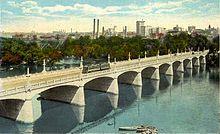
By the beginning of the twentieth century, the city's population had reached 85,050 in 5 square miles (13 km2), making it the most densely populated city in the Southern United States. In 1900, the Census Bureau reported Richmond's population as 62.1% white and 37.9% black. Freed slaves and their descendants created a thriving African-American business community, and the city's historic Jackson Ward became known as the "Wall Street of Black America." In 1903, African-American businesswoman and financier Maggie L. Walker chartered St. Luke Penny Savings Bank, and served as its first president, as well as the first female bank president in the United States. Today, the bank is called the Consolidated Bank and Trust Company, and it is the oldest surviving African-American bank in the U.S. Other figures from this time included John Mitchell, Jr. In 1910, the former city of Manchester was consolidated with the city of Richmond, and in 1914, the city annexed Barton Heights, Ginter Park, and Highland Park areas of Henrico County. In May 1914, Richmond became the headquarters of the Fifth District of the Federal Reserve Bank.
Several major performing arts venues were constructed during the 1920s, including what are now the Landmark Theatre, Byrd Theatre, and Carpenter Theatre. The city's first radio station, WRVA, began broadcasting in 1925. WTVR-TV (CBS 6), the first television station in Richmond, was the first television station south of Washington, D.C.
Between 1963 and 1965, there was a "downtown boom" that led to the construction of more than 700 buildings in the city. In 1968, Virginia Commonwealth University was created by the merger of the Medical College of Virginia with the Richmond Professional Institute. In 1970, Richmond's borders expanded by an additional 27 square miles (70 km2) on the south. After several years of court cases in which Chesterfield County fought annexation, more than 47,000 people who once were Chesterfield County residents found themselves within the city's perimeters on January 1, 1970. In 1996, still-sore tensions arose amid controversy involved in placing a statue of African American Richmond native and tennis star Arthur Ashe to the famed series of statues of Confederate heroes of the Civil War on Monument Avenue. After several months of controversy, the bronze statue of Ashe was finally completed on Monument Avenue facing the opposite direction from the Confederate Heroes on July 10, 1996.
A multi-million dollar flood wall was completed in 1995, in order to protect low-lying areas of city from the oft-rising waters of the James River. As a result the River District businesses grew rapidly, and today the area is home to much of Richmond's entertainment, dining and nightlife activity, bolstered by the creation of a Canal Walk along the city's former industrial canals.
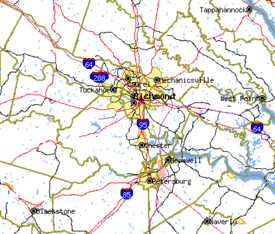
Richmond is located at 37 °32 a²18.05 a³N 77 °27 a²41.42 a³W / 37.5383472 °N 77.4615056 °W / 37.5383472; -77.4615056 (37.538346, na77.461507). According to the United States Census Bureau, the city has a total area of 62.5 square miles (162 km2). 60.1 sq mi (156 km2) of it is land and 2.5 sq mi (6.5 km2) of it (3.96%) is water. The city is located in the Piedmont region of Virginia, at the highest navigable point of the James River. The Piedmont region is characterized by relatively low, rolling hills, and lies between the low, sea level Tidewater region and the Blue Ridge Mountains. Significant bodies of water in the region include the James River, the Appomattox River, and the Chickahominy River.
The Richmond-Petersburg Metropolitan Statistical Area (MSA), the 43rd largest in the United States, includes the independent cities of Richmond, Colonial Heights, Hopewell, and Petersburg, as well as the counties of Charles City, Chesterfield, Dinwiddie, Goochland, Hanover, Henrico, New Kent, Powhatan, and Prince George. As of July 1, 2009 (2009 -07-01)[update], the total population of the Richmond aePetersburg MSA was 1,258,251.
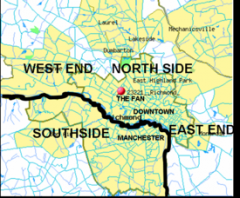
Richmond's original street grid, laid out in 1737, included the area between what are now Broad, 17th, and 25th Streets and the James River. Modern Downtown Richmond is located slightly farther west, on the slopes of Shockoe Hill. Nearby neighborhoods include Shockoe Bottom, the historically significant and low-lying area between Shockoe Hill and Church Hill, and Monroe Ward, which contains the Jefferson Hotel. Richmond's East End includes neighborhoods like rapidly gentrifying Church Hill, home to St. John's Church, as well as poorer areas like Fulton, Union Hill, and Fairmont, and public housing projects like Mosby Court, Whitcomb Court, Fairfield Court, and Creighton Court closer to Interstate 64.
The area between Belvidere Street, Interstate 195, Interstate 95, and the river, which includes Virginia Commonwealth University, is socioeconomically and architecturally diverse. North of Broad Street, the Carver and Newtowne West neighborhoods are demographically similar to neighboring Jackson Ward, with Carver experiencing some gentrification due to its proximity to VCU. The affluent area between the Boulevard, Main Street, Broad Street, and VCU, known as the Fan, is home to Monument Avenue, an outstanding collection of Victorian architecture, and many students. West of the Boulevard is the Museum District, the location of the Virginia Historical Society and the Virginia Museum of Fine Arts. South of the Downtown Expressway are Byrd Park, Maymont, Hollywood Cemetery, the predominantly black working class Randolph neighborhood, and white working class Oregon Hill. Cary Street between Interstate 195 and the Boulevard is a popular commercial area called Carytown.
Further to the west is the affluent, suburban West End. The West End also includes middle to lower income neighborhoods, such as Dumbarton and Lakeside, which can be found directly north of the city, Laurel, Farmington and the areas surrounding the Regency Mall. More affluent areas include Glen Allen, Tuckahoe, and Short Pump, which can all be found north and northwest of the city. The University of Richmond and the Country Club of Virginia can be found here as well, which are located just inside the City Limits.
The portion of the city south of the James River is known as the Southside. Neighborhoods in the city's Southside area range from affluent and middle class suburban neighborhoods like Westover Hills, Forest Hill, Southampton, Stratford Hills, Oxford, Huguenot Hills, Hobby Hill, and Woodland Heights to the impoverished Manchester and Blackwell areas, the Hillside Court housing projects, and the ailing Jefferson Davis Highway commercial corridor. Other Southside neighborhoods include Fawnbrook, Broad Rock, Cherry Gardens, Cullenwood, and Beaufont Hills. Much of Southside developed a suburban character as part of Chesterfield County before being annexed by Richmond, most notably in 1970.
The other side of the city, the Northside, began to develop at the end of the 19th century when the new streetcar system made it possible for people to live on the outskirts of town and still commute to jobs downtown. Prominent Northside neighborhoods include Azalea, Barton Heights, Bellevue, Chamberlayne, Ginter Park, Highland Park, and Rosedale.
Richmond has a humid subtropical climate (Koppen Cfa), with hot and humid summers and generally mild winters. The mountains to the west act as a partial barrier to outbreaks of cold, continental air in winter. The cold winter air is delayed long enough to be modified, then further warmed as it subsides in its approach to Richmond. The open waters of the Chesapeake Bay and Atlantic Ocean contribute to the humid summers and mild winters. The coldest weather normally occurs from late December to early February, when low temperatures usually average in the upper 20s °F ( na3 to na2 °C), and the high temperatures in the mid-upper 40s (7 to 9 °C). Temperatures seldom lower to zero, but there have been occurrences of subzero (below na18 °C) temperatures aemost recently January 28, 2000 when the temperature reached na1 °F ( na18 °C). Summertime high temperatures reach 90 °F (32 °C) approximately 43 days out of the year, and while 100 °F (38 °C) temperatures are not uncommon, they do not occur every year.
Precipitation is rather uniformly distributed throughout the year. However, dry periods lasting several weeks do occur, especially in autumn when long periods of pleasant, mild weather are most common. There is considerable variability in total monthly amounts from year to year so that no one month can be depended upon to be normal. Snow has been recorded during seven of the twelve months. Falls of 4 inches (10 cm) or more occur on average of once a year. Annual snowfall, however, is usually light averaging 12 inches (300 mm) per season. Snow typically remains on the ground only one or two days at a time, but recently remained as much as 16 days (January 30 to February 14, 2010). Ice storms (freezing rain or glaze) are not uncommon, but they are seldom severe enough to do any considerable damage.
The James River reaches tidewater at Richmond where flooding may occur in every month of the year, most frequently in March and least in July. Hurricanes and tropical storms have been responsible for most of the flooding during the summer and early fall months. Hurricanes passing near Richmond have produced record rainfalls. In 1955, three hurricanes brought record rainfall to Richmond within a six-week period. The most noteworthy of these were Hurricane Connie and Hurricane Diane that brought heavy rains five days apart. And in 2004, Richmond's downtown suffered extensive flood damage after the remnants of Hurricane Gaston dumped up to 12 inches (300 mm) of rainfall.
Damaging storms occur mainly from snow and freezing rain in winter and from hurricanes, tornadoes, and severe thunderstorms in other seasons. Damage may be from wind, flooding, or rain, or from any combination of these. Tornadoes are infrequent but some notable occurrences have been observed within the Richmond area.
Based on the 1971 ae2000 period, the average first occurrence of at or below freezing temperatures in the fall is October 29 and the average last occurrence in the spring is April 8.
As of the 2005 ae2007 American Community Survey conducted by the U.S. Census Bureau, White Americans made up 41.6% of Richmond's population (39.5% non-Hispanic whites), Blacks or African Americans made up 52.3% of Richmond's population (52.1% non-Hispanic blacks). American Indians made up 0.4% of the city's population; of which 75% were non-Hispanic. Asian Americans made up 1.6% of the city's population. Pacific Islander Americans made up less than 0.1% of the city's population. Individuals from some other race made up 1.7% of the city's population; of which 0.2% were non-Hispanic. Individuals from two or more races made up 2.4% of the city's population; of which 2.1% were non-Hispanic. In addition, Hispanics and Latinos made up 4.2% of Richmond's population. Non-Hispanic Whites were 39.1% of the population in 2010, compared to 57.0% in 1970.
As of the census of 2000, there were 197,790 people, 84,549 households, and 43,627 families residing in the city. The population density was 3,292.6 people per square mile (1,271.3/km ²). There were 92,282 housing units at an average density of 1,536.2 per square mile (593.1/km ²). The racial makeup of the city was 38.3% White, 57.2% African American, 0.2% Native American, 1.3% Asian, 0.1% Pacific Islander, 1.5% from other races, and 1.5% from two or more races. Hispanic or Latino of any race were 2.6% of the population.
There were 84,549 households out of which 23.1% had children under the age of 18 living with them, 27.1% were married couples living together, 20.4% had a female householder with no husband present, and 48.4% were non-families. 37.6% of all households were made up of individuals and 10.9% had someone living alone who was 65 years of age or older. The average household size was 2.21 and the average family size was 2.95.
In the city the age distribution of the population shows 21.8% under the age of 18, 13.1% from 18 to 24, 31.7% from 25 to 44, 20.1% from 45 to 64, and 13.2% who were 65 years of age or older. The median age was 34 years. For every 100 females there were 87.1 males. For every 100 females age 18 and over, there were 83.5 males.
The median income for a household in the city was $31,121, and the median income for a family was $38,348. Males had a median income of $30,874 versus $25,880 for females. The per capita income for the city was $20,337. About 17.1% of families and 21.4% of the population were below the poverty line, including 32.9% of those under age 18 and 15.8% of those age 65 or over.
During the late 1980s and early 1990s, Richmond experienced a spike in overall crime, in particular, the city's murder rate. The city had 93 murders for the year of 1985, with a murder rate of 41.9 killings committed per 100,000 residents. Over the next decade, the city saw a major increase in total homicides. In 1990 there were 114 murders, for a murder rate of 56.1 killings per 100,000 residents. There were 120 murders in 1995, resulting in a murder rate of 59.1 killings per 100,000 residents, one of the highest in the United States.
In 2004, Morgan Quitno Press ranked Richmond as the ninth (out of 354) most dangerous city in the United States. In 2005, Richmond was ranked as the fifth most dangerous city overall and the twelfth most dangerous metropolitan area in the United States. The following year, Richmond saw a decline in crime, ranking as the fifteenth most dangerous city in the United States. By 2008, Richmond's position on the list had fallen to 49th.
Richmond's rate of major crime, including violent and property crimes, decreased 47 percent between 2004 and 2009 to its lowest level in more than a quarter of a century. Various forms of crime tend to be declining, yet remaining above state and national averages. In 2008, the city had recorded the lowest homicide rate since 1971.
FBI Uniform Crime Reports for Richmond for the year of 2009:
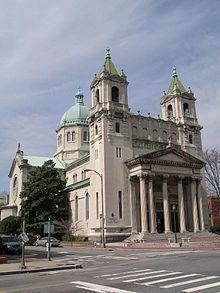
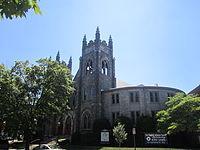
In 1786, the Virginia Statute for Religious Freedom, penned in 1779 by Thomas Jefferson, was adopted by the Virginia General Assembly in Richmond. The site is now commemorated by the First Freedom Center.
Richmond has several historic churches. Because of its early English colonial history from the early 17th century to 1776, Richmond has a number of prominent Anglican/Episcopal churches including Monumental Church, St. Paul's Episcopal Church and St. John's Episcopal Church. Methodists and Baptists made up another section of early churches, and First Baptist Church of Richmond was the first of these, established in 1780. In the Reformed church tradition, the first Presbyterian Church in the City of Richmond was First Presbyterian Church, organized on June 18, 1812. On February 5, 1845, Second Presbyterian Church of Richmond was founded, which was a historic church where Stonewall Jackson attended and was the first Gothic building and the first gas-lit church to be built in Richmond. St. Peter's Church was dedicated and became the first Catholic church in Richmond on May 25, 1834. The city is also home to the historic Cathedral of the Sacred Heart which is the motherchurch for the Roman Catholic Diocese of Richmond
The first Jewish congregation in Richmond was Kahal Kadosh Beth Shalom. Kahal Kadosh Beth Shalom was the sixth congregation in the United States. By 1822 K.K. Beth Shalom members worshipped in the first synagogue building in Virginia. They eventually merged with Congregation Beth Ahabah, an offshoot of Beth Shalom. There are two Orthodox Synagogues, Keneseth Beth Israel and Chabad of Virginia. There is an Orthodox Yeshivah K ae12 school system known as Rudlin Torah academy, which also includes a post high-school program. There are two Conservative synagogues, Beth El and Or Atid. There are two Reform synagogues, Beth Ahabah and Or Ami. Along with such religious congregations, there are a variety of other Jewish charitable, educational and social service institutions, each serving the Jewish and general communities. These include the Weinstein Jewish Community Center, Jewish Family Services, Jewish Community Federation of Richmond and Richmond Jewish Foundation.
Due to the influx of German immigrants in the 1840s, Saint Johns German Evangelical church was formed in 1843. Saints Constantine and Helen Greek Orthodox Cathedral held its first worship service in a rented room at 309 North 7th Street in 1917. The cathedral relocated to 30 Malvern Avenue in 1960 and is noted as one of two Eastern Orthodox churches in Richmond and home to the annual Richmond Greek Festival.
There are seven current masjids in the Greater Richmond area, with three more currently in construction, accommodating the growing Muslim population. The first one being Masjid Bilal. In the 1950s, Muslims from the East End got organized under Nations of Islam (NOI). They used to meet in Temple #24 located on North Avenue. After the NOI split in 1975, the Muslims who joined mainstream Islam, start meeting at Shabaaz Restaurant on Nine Mile Road. By 1976, the Muslims used to meet in a rented church. They tried to buy this church, but due to financial difficulties the Muslims instead bought an old grocery store at Chimbarazoo Boulevard, the present location of Masjid Bilal. Initially, the place was called auMasjid Muhammad #24. au Only by 1990 did the Muslims renamed it to auMasjid Bilal au. Masjid Bilal was followed by the Islamic Center of Virginia, ICVA masjid. The ICVA was established in 1973 as a non profit tax exempt organization. With aggressive fundraising, ICVA was able to buy land on Buford road. Construction of the new masjid began in early 1980s. The rest of the five current masjids in the Richmond area are Islamic Center of Richmond (ICR) in the west end, Masjid Umm Barakah on 2nd street downtown, Islamic Society of Greater Richmond (ISGR) in the west end, Masjidullah in the north side, and Masjid Ar-Rahman in the east end.
Hinduism is very large as well in the area, especially in the suburban areas of Henrico and Chesterfield. Local estimates say that there are approximately 6,000 families of Indian descent are residing in the Richmond Region as of 2011. All are served by several temples and cultural centers across the region, the two most familiar being the Cultural Center of India (CCI) located off of Iron Bridge Road in Chesterfield County, and the Hindu Center of Virginia in Henrico County which has garnered national fame and awards for being the first LEED certified religious facility in the state. Both were planned and built by NBJ Architects, a local architecture firm.
There are several seminaries in Richmond. These include a theology school at Virginia Union University, a Presbyterian seminary called Union Presbyterian Seminary, and a Baptist seminary known as Baptist Theological Seminary at Richmond. The McCollough Theological Seminary of the United House of Prayer For All People is located in the Church Hill neighborhood of the City.
Bishops that sit in Richmond include those of the Episcopal Diocese of Virginia (the denomination's largest); the Richmond Area of the United Methodist Church (Virginia Annual Conference), the nation's second-largest and one of the oldest. The Presbytery of the James aePresbyterian Church (USA) ae also is based in the Richmond area.
The Roman Catholic Diocese of Richmond was canonically erected by Pope Pius VII on July 11, 1820. Today there are 235,816 Catholics at 146 parishes in the Diocese of Richmond. The city of Richmond is home to 19 Catholic parishes. Cathedral of the Sacred Heart is home to the current bishop Most Reverend Francis Xavier DiLorenzo who was appointed by Pope John Paul II on March 31, 2004.
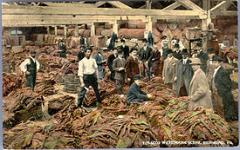
Richmond's strategic location on the James River, built on undulating hills at the rocky fall line separating the Piedmont and Tidewater regions of Virginia, provided a natural nexus for the development of commerce. Throughout these three centuries and three modes of transportation, the downtown has always been a hub, with the Great Turning Basin for boats, the world's only triple crossing of rail lines, and the intersection of two major interstates.
Law and finance have long been driving forces in the economy. The city is home to both the United States Court of Appeals for the Fourth Circuit, one of 13 United States courts of appeals, and the Federal Reserve Bank of Richmond, one of 12 Federal Reserve Banks, as well as offices for international companies such as Genworth Financial, CapitalOne, Philip Morris USA, and numerous other banks and brokerages. Richmond is also home to four of the largest law firms in the United States: Hunton & Williams, McGuireWoods, Williams Mullen, and LeClairRyan. Another law firm with a major Richmond presence is Troutman Sanders, which merged with Richmond-based Mays & Valentine LLP in 2001.
Since the 1960s Richmond has been a prominent hub for advertising agencies and advertising related businesses, including The Martin Agency, named 2009 U.S. Agency of the Year by AdWeek. As a result of local advertising agency support, VCU's graduate advertising school (VCU Brandcenter) is consistently ranked the No. 1 advertising graduate program in the country.
Richmond is home to the rapidly developing Virginia BioTechnology Research Park, which opened in 1995 as an incubator facility for biotechnology and pharmaceutical companies. Located adjacent to the Medical College of Virginia (MCV) Campus of Virginia Commonwealth University, the park currently[when?] has more than 575,000 square feet (53,400 m2) of research, laboratory and office space for a diverse tenant mix of companies, research institutes, government laboratories and non-profit organizations. The United Network for Organ Sharing, which maintains the nation's organ transplant waiting list, occupies one building in the park. Philip Morris USA opened a $350 million research and development facility in the park in 2007. Once fully developed, park officials expect the site to employ roughly 3,000 scientists, technicians and engineers.
Richmond's revitalized downtown includes the Canal Walk, a new Greater Richmond Convention Center, and expansion on both VCU campuses. A new performing arts center, Richmond CenterStage, opened on September 12, 2009. The complex included a renovation of the Carpenter Center and construction of a new multipurpose hall, community playhouse, and arts education center in parts of the old Thalhimers department store.
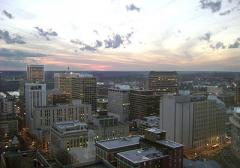
The Greater Richmond area was named the third-best city for business by MarketWatch in September 2007, ranking behind only the Minneapolis and Denver areas and just above Boston. The area is home to six Fortune 500 companies: electric utility Dominion Resources; CarMax; Owens & Minor; Genworth Financial; MeadWestvaco; and Altria Group. However, only Dominion Resources and MeadWestvaco are headquartered within the city of Richmond; the others are located in the neighboring counties of Henrico and Hanover. In 2008, Altria moved its corporate HQ from New York City to Richmond, adding another Fortune 500 corporation to Richmond's list. In February 2006, MeadWestvaco announced that they would move from Stamford, Connecticut, to Richmond in 2008. The company completed an 8 ae10 story office building downtown in 2010, near the Federal Reserve building.
Other Fortune 500 companies, while not headquartered in the area, do have a major presence. These include SunTrust Bank (based in Atlanta), Capital One Financial Corporation (officially based in McLean, Virginia, but founded in Richmond with its operations center and most employees in the Richmond area), and the medical and pharmaceutical giant McKesson (based in San Francisco). Capital One and Altria company's Philip Morris USA are two of the largest private Richmond-area employers. DuPont maintains a production facility in South Richmond known as the Spruance Plant. UPS Freight, the less-than-truckload division of UPS and formerly known as Overnite Transportation, has its corporate headquarters in Richmond.
Richmond is also home to the Southern States Cooperative, one of the largest farm supply cooperatives in the US. As a result of its leadership role in agriculture, Southern States has continued to expand and today encompasses some 1,200 retail locations in 23 states. Owned by more than 300,000 farmers since 1923, the cooperative purchases, manufactures or processes feed, seed, fertilizer, farm supplies and fuel.
Other companies based in Richmond include chemical company NewMarket; Universal Corporation, a tobacco merchant; Cavalier Telephone, a telephone, internet, and digital television provider formed in Richmond in 1998; and Cherry Bekaert & Holland, a top 30 accounting firm serving the Southeast.
Richmond was the home of the Ukrop's Super Market, a regional, family-owned chain of supermarkets known for its customer service and innovation. Ukrop's was a high-profile sponsor of community events, such as the Monument Avenue 10K, Easter on Parade, and the Ukrop's Christmas Parade. However, the chain announced that it would be sold to Giant Food Stores, a subsidiary of Dutch conglomerate Ahold, in February 2010. The stores now operate under the brand "Martin's" though they continue to sell Ukrop's bakery and prepared food items.
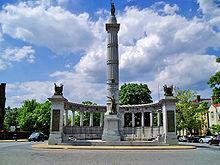
Several of the city's large general museums are located near the Boulevard. On Boulevard proper are the Virginia Historical Society and the Virginia Museum of Fine Arts, lending their name to what is sometimes called the "Museum District". Nearby on Broad Street is the Science Museum of Virginia, housed in the neoclassical former 1919 Broad Street Union Station. Immediately adjacent is the Children's Museum of Richmond, and two blocks away, the Virginia Center for Architecture. Within the downtown are the Library of Virginia and the Valentine Richmond History Center. Elsewhere are the Virginia Holocaust Museum and the Old Dominion Railway Museum.
As the primary former Capital of the Confederate States of America, Richmond is home to many museums and battlefields of the American Civil War. Near the riverfront is the Richmond National Battlefield Park Visitors Center and the American Civil War Center at Historic Tredegar, both housed in the former buildings of the Tredegar Iron Works, where much of the ordnance for the war was produced. In Court End, near the Virginia State Capitol, is the Museum of the Confederacy, along with the Davis Mansion, also known as the White House of the Confederacy; both feature a wide variety of objects and material from the era. The temporary home of former Confederate General Robert E. Lee still stands on Franklin Street in downtown Richmond. The history of slavery and emancipation are also increasingly represented: there is a former slave trail along the river that leads to Ancarrow's Boat Ramp and Historic Site which has been developed with interpretive signage, and in 2007, the Reconciliation Statue was placed in Shockoe Bottom, with parallel statues placed in Liverpool and Benin representing points of the Triangle Trade.
Other historical points of interest include St. John's Church, the site of Patrick Henry's famous "Give me liberty or give me death" speech, and the Edgar Allan Poe Museum, features many of his writings and other artifacts of his life, particularly when he lived in the city as a child, a student, and a successful writer. The John Marshall House, the home of the former Chief Justice of the United States, is also located downtown and features many of his writings and objects from his life. Hollywood Cemetery is the burial grounds of two U.S. Presidents as well as many Civil War officers and soldiers.
The city is home to many monuments and memorials, most notably those along Monument Avenue. Other monuments include the A.P. Hill monument, the Bill "Bojangles" Robinson monument in Jackson Ward, the Christopher Columbus monument near Byrd Park, and the Confederate Soldiers and Sailors Monument on Libby Hill. Located near Byrd Park is the famous World War I Memorial Carillon, a 56-bell carillon tower. Dedicated in 1956, the Virginia War Memorial is located on Belvedere overlooking the river, and is a monument to Virginians who died in battle in World War II, the Korean War, the Vietnam War, the Gulf War, the War in Afghanistan, and the Iraq War.
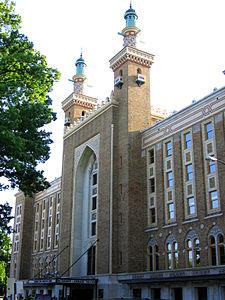
Richmond has a significant arts community, some of which is contained in formal public-supported venues, and some of which is more DIY, such as local privately owned galleries, and private music venues, or organic and venueless arts movements (e.g., house shows, busking, itinerant folk shows). This has led to tensions, as the city Richmond City levied an "admissions tax" to fund large arts projects like CentreStage, leading to criticism that it is funding civic initiatives on the backs of the organic local culture. Traditional Virginian folk music, including blues, country, and bluegrass are also notably present, and play a large part in the annual Richmond Folk Festival. The following is a list of the more formal arts establishments (Companies, theaters, galleries, and other large venues) in Richmond:
Other venues and companies include:
Commercial art galleries include Metro Space Gallery and Gallery 5 in a newly designated arts district.
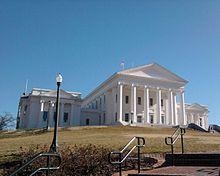
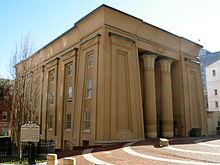
Richmond is home to many significant structures, including some designed by notable architects. The city contains diverse styles, including significant examples of Georgian, Federal, Greek Revival, Neoclassical, Egyptian Revival, Romanesque Revival, Gothic Revival, Tudor Revival, Italianate, Queen Anne, Colonial Revival, Art Deco, Modernist, International, and Postmodern buildings.
Much of Richmond's early architecture was destroyed by the Evacuation Fire in 1865. It is estimated that 25% of all buildings in Richmond were destroyed during this fire. Even fewer now remain due to construction and demolition that has taken place since Reconstruction. In spite of this, Richmond contains many historically significant buildings and districts. Buildings remain from Richmond's colonial period, such as the Patteson-Schutte House and the Edgar Allan Poe Museum (Richmond, Virginia), both built before 1750.
Architectural classicism is heavily represented in all districts of the city, particularly in Downtown, the Fan, and the Museum District. Several notable classical architects have designed buildings in Richmond. The Virginia State Capitol was designed by Thomas Jefferson and Charles-Louis Clerisseau in 1785. It is the second-oldest US statehouse in continuous use (after Maryland's) and was the first US government building built in the neo-classical style of architecture, setting the trend for other state houses and the federal government buildings (including the White House and The Capitol) in Washington, D.C. Robert Mills designed Monumental Church on Broad Street. Adjoining it is the 1845 Egyptian Building, one of the few Egyptian Revival buildings in the United States. The firm of John Russell Pope designed Broad Street Station as well as Branch House on Monument Avenue, designed as a private residence in the Tudor style, now serving as the Virginia Center for Architecture. Broad Street Station (or Union Station), designed in the Beaux-Arts style, is no longer a functioning station but is now home to the Science Museum of Virginia. Main Street Station, designed by Wilson, Harris, and Richards, has been returned to use in its original purpose. The Jefferson Hotel and the Commonwealth Club were both designed by the classically trained Beaux-Arts architects Carrere and Hastings. Many buildings on the University of Richmond campus, including Jeter Hall and Ryland Hall, were designed by Ralph Adams Cram, most famous for his Princeton University Chapel and the Cathedral of Saint John the Divine.
Richmond's urban residential neighborhoods also hold particular significance to the city's fabric. The Fan, the Museum District, Jackson Ward, Carver, Carytown, Oregon Hill and Church Hill (among others) are largely single use town homes and mixed use or full retail/dining establishments. These districts are anchored by large streets such as Franklin Street, Cary Street, the Boulevard, and Monument Avenue. The city's growth in population over the last decade has been concentrated in these areas.
Among Richmond's most interesting architectural features is its Cast-iron architecture. Second only to New Orleans in its concentration of cast iron work, the city is home to a unique collection of cast iron porches, balconies, fences, and finials. Richmond's position as a center of iron production helped to fuel its popularity within the city. At the height of production in the 1890, 25 foundries operated in the city employing nearly 3,500 metal workers. This number is seven times the number of general construction workers being employed in Richmond at the time which illustrates the importance of its iron exports. Porches and fences in urban neighborhoods such as Jackson Ward, Church Hill, and Monroe Ward are particularly elaborate, often featuring ornate iron casts never replicated outside of Richmond. In some cases cast were made for a single residential or commercial application.
Richmond is home to several notable instances of various styles of modernism. Minoru Yamasaki designed the Federal Reserve Building which dominates the downtown skyline. The firm Skidmore, Owings and Merrill has designed two buildings: the Library of Virginia and the General Assembly Offices at the Eighth and Main Building. Philip Johnson designed the WRVA Building. The Richard Neutra-designed Rice House, a residence on a private island on the James River, remains Richmond's only true International Style home. The W.G. Harris residence in Richmond was designed by famed early modern architect and member of the Harvard Five, Landis Gores. Other notable architects to have worked in the city include Rick Mather, I.M. Pei, and Gordon Bunshaft.
VCU is currently raising funds for a new Institute of Contemporary Arts designed by Steven Holl. The ICA is to be funded by private donors and will hopefully be opened by 2015.
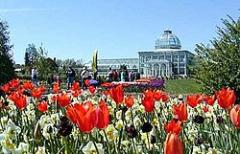
The city operates one of the oldest municipal park systems in the country. The park system began when the city council voted in 1851 to acquire 7.5 acres (30,000 m2), now known as Monroe Park. Today, Monroe Park sits adjacent to the Virginia Commonwealth University campus and is one of more than 40 parks comprising a total of more than 1,500 acres (610 ha).
Several parks are located along the James River, and the James River Parks System offers bike trails, hiking and nature trails, and many scenic overlooks along the river's route through the city. The trails are used as part of the Xterra East Championship course for both the running and mountain biking portions of the off-road triathlon.
There are also parks on two major islands in the river: Belle Isle and Brown's Island. Belle Isle, at various former times a Powhatan fishing village, colonial-era horse race track, and Civil War prison camp, is the larger of the two, and contains many bike trails as well as a small cliff that is used for rock climbing instruction. One can walk the island and still see many of the remains of the Civil War prison camp, such as an arms storage room and a gun emplacement that was used to quell prisoner riots. Brown's Island is a smaller island and a popular venue of a large number of free outdoor concerts and festivals in the spring and summer, such as the weekly Friday Cheers concert series or the James River Beer and Seafood Festival.
Two other major parks in the city along the river are Byrd Park and Maymont, located near the fan district. Byrd Park features a one mile (1.6 km) running track, with exercise stops, a public dog park, and a number of small lakes for small boats, as well as two monuments, Buddha house, and an amphitheatre. Prominently featured in the park is the World War I Memorial Carillon, built in 1926 as a memorial to those that died in the war. Maymont, located adjacent to Byrd Park, is a 100-acre (40 ha) Victorian estate with a museum, formal gardens, native wildlife exhibits, nature center, carriage collection, and children's farm. Other parks in the city include Joseph Bryan Park Azalea Garden, Forest Hill Park (former site of the Forest Hill Amusement Park), Chimborazo Park (site of the National Battlefield Headquarters), among others.
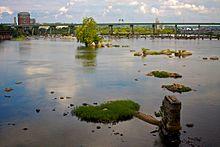
The James River itself through Richmond is renowned as one of the best in the country for urban white-water rafting/canoeing/kayaking. Several rafting companies offer complete services. There are also several easily accessed riverside areas within the city limits for rock-hopping, swimming, and picnicking.
Lewis Ginter Botanical Garden is located adjacent to the city in Henrico County. Founded in 1984, Lewis Ginter Botanical Garden is located on 80 acres (320,000 m2) and features a glass conservatory, a rose garden, a healing garden, and an accessible-to-all children's garden. The Garden is a public place for the display and scientific study of plants. Lewis Ginter Botanical Garden is one of only two independent public botanical gardens in Virginia and is designated a state botanical garden.
Several theme parks are also located near the city, including Kings Dominion to the north, and Busch Gardens to the east, near Williamsburg.
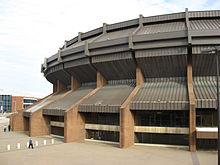
Richmond does not host regular season games for any major league professional sports teams, however, starting in 2013, the Washington Redskins of the National Football League will conduct their summer training camp in Richmond. There are also several minor league sports in the city, including the Richmond Kickers of the United Soccer League and the Richmond Flying Squirrels of the Class AA Eastern League of Minor League Baseball (an affiliate of the San Francisco Giants). The Kickers began playing in Richmond in 1993, and currently play at City Stadium. The Squirrels opened their first season at The Diamond on April 15, 2010. From 1966 through 2008, Richmond hosted the Richmond Braves, a AAA affiliate of the Atlanta Braves of Major League Baseball, until they were moved to Gwinnett County, Georgia.
The city also has hosted the Richmond Raiders of the Professional Indoor Football League since 2010, who play at the Richmond Coliseum downtown.[100] The Coliseum is a 13,000-plus seat multi-purpose arena which also hosts a large number of sporting events, concerts, festivals, and trade shows. The venue also hosted the Richmond Renegades of the East Coast Hockey League from 1990 ae 2003.[101] The team attempted to revive again as a Southern Professional Hockey League franchise from 2006 ae 2009.[102] The VCU Rams men's and women's basketball teams (Atlantic 10 Conference) also played at the Coliseum until completion of the Stuart C. Siegel Center in 1999. Also playing in the Atlantic 10 is the University of Richmond Spiders, who play their basketball games at the 9,071-seat Robins Center. The University of Richmond also plays their college football games at Robins Stadium, recently completed in 2010.
Richmond is also home to the 6,000-seat Arthur Ashe Athletic Center, another multi-purpose arena named for tennis great and Richmond resident Arthur Ashe. This facility also hosts a variety of local sporting events, concerts, and other activities. The site also briefly hosted the Richmond Revolution of the Indoor Football League (not to be confused with Richmond Raiders) in 2010 and 2011.[103][104] As the home of Arthur Ashe, the sport of tennis is also popular in Richmond, and in 2010, the United States Tennis Association named Richmond as the third "Best Tennis Town", behind Charleston, South Carolina, and Atlanta, Georgia.[105]
Auto racing is very popular in the area. The Richmond International Raceway (RIR) has hosted NASCAR Sprint Cup races since 1953, as well as the Capital City 400 from 1962 ae 1980.[106] RIR also hosted IndyCar's Suntrust Indy Challenge from 2001 ae 2009. Another track, Southside Speedway, has operated since 1959 and sits just southwest of Richmond in Chesterfield County. This 33-mile (53 km) oval short-track has become known as the "Toughest Track in the South", and features weekly stock car racing on Friday nights.[107] Southside Speedway has acted as the breeding grounds for many past NASCAR legends including Richard Petty, Bobby Allison and Darrell Waltrip, and claims to be the home track of NASCAR superstar Denny Hamlin.[108][109]
Richmond has played host to the Xterra (off-road triathlon) East Championship since 1998 on the trails of the James River Park, and will host the 2015 UCI Road World Championships.[110][111]
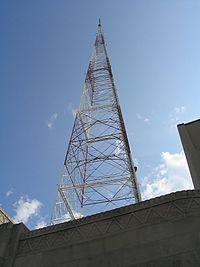
The Richmond Times-Dispatch is the local daily newspaper in Richmond, with a Sunday circulation of 215,000, owned by Media General. Style Weekly is a standard weekly publication covering popular culture, arts, and entertainment, owned by Landmark Communications. Richmond Magazine is a monthly magazine. RVA Magazine is the city's only independent art music and culture publication, was once monthly, but is now issued quarterly. The Richmond Free Press and the Voice cover the news from an African-American perspective. Spanish-language publications in the city include the newspaper, Centro.
The Richmond metro area is served by many local television and radio stations. As of 2010[update], the Richmond-Petersburg designated market area (DMA) is the 58th largest in the U.S. with 553,950 homes according to Nielsen Market Research.[112] The major network television affiliates are WTVR-TV 6 (CBS), WRIC-TV 8 (ABC), WWBT 12 (NBC), WRLH-TV 35 (Fox), and WUPV 65 (CW). Public Broadcasting Service stations include WCVE-TV 23 and WCVW 57. There are also a wide variety of radio stations in the Richmond area, catering to many different interests, including news, talk radio, and sports, as well as an eclectic mix of musical interests.
Many films and television shows have been filmed, in whole or in part, in Richmond, including The Box, Finnegan Begin Again, Hannibal, The Jackal, Hearts in Atlantis, The Contender, Shadow Conspiracy, Evan Almighty, and Iron Jawed Angels.[113] Locations featured in the 1990s television cartoon, "Doug", are named after or inspired by areas in Richmond and nearby counties as creator Jim Jinkins was born and raised in Richmond.
Richmond's elite society has also been portrayed in various popular culture references, such as in 1920s novels by Ellen Glasgow and James Branch Cabell, or the 1990s television sitcom A Different World, which featured the character Whitley Gilbert, an obnoxious and wealthy African American debutante.[114] The 2009 TNT television drama HawthoRNe, starring Jada Pinkett Smith and Michael Vartan, is set at the fictitious Richmond-Trinity Hospital which is based on Richmond's Community Hospital in Church Hill.[115]
Richmond has originated and been home to many musicians, including GWAR, D'Angelo, Lamb of God, Avail, Fighting Gravity, Municipal Waste, Trey Songz and Carbon Leaf.
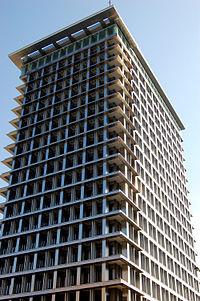
Richmond city government consists of a city council with representatives from nine districts serving in a legislative and oversight capacity, as well as a popularly elected, at-large mayor serving as head of the executive branch. Citizens in each of the nine districts elect one council representative each to serve a four-year term. Beginning with the November 2008 election Council terms was lengthened to 4 years. The city council elects from among its members one member to serve as Council President and one to serve as Council Vice President. The city council meets at City Hall, located at 900 E. Broad St., 2nd Floor, on the second and fourth Mondays of every month, except August.
In 1977, a federal district court ruled in favor of Curtis Holt Jr. who had claimed the councils existing election process ae an at large voting system ae was racially biased. The verdict required the city to rebuild its council into 9 distinct wards. Within the year the city council switched from majority white to majority black, reflecting the city's populace. This new city council elected Richmond's first black mayor, Henry L. Marsh.
In 1990 religion and politics intersected to impact the outcome of the Eighth District election in South Richmond. With the endorsements of black power brokers, black clergy and the Richmond Crusade for Voters, South Richmond residents made history, electing Reverend A. Carl Prince to the Richmond City Council. As the first African American Baptist Minister elected to the Richmond City Council, Prince's election paved the way for a political paradigm shift in politics that persist today. Following Prince's election, Reverend Gwendolyn Hedgepeth and the Reverend Leonidas Young, former Richmond Mayor were elected to public office. Prior to Prince's election black clergy made political endorsements and served as appointees to the Richmond School Board and other boards throughout the city. Today religion and politics continues to thrive in the Commonwealth of Virginia. The Honorable Dwight C. Jones, a prominent Baptist pastor and former Chairman of the Richmond School Board and Member of the Virginia House of Delegates serves as Mayor of the City of Richmond.
Richmond's government changed in 2004 from a council-manager form of government to an at-large, popularly elected Mayor. In a landslide election, incumbent mayor Rudy McCollum was defeated by L. Douglas Wilder, who previously served Virginia as the first elected African American governor in the United States since Reconstruction. The current[when?] mayor of Richmond is Dwight Clinton Jones. The mayor is not a part of the Richmond City Council.
As of March 2009[update], the Richmond City Council consisted of: Kathy C. Graziano, 4th District, President of Council; Ellen F. Robertson, 6th District, Vice-President of Council; Bruce Tyler, 1st District; Charles R. Samuels, 2nd District; Chris A. Hilbert, 3rd District; E. Martin (Marty) Jewell, 5th District; Cynthia I Newbille, 7th District; Reva M. Trammell, 8th District; and Douglas G. Conner Jr., 9th District.
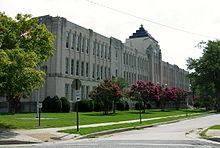
The city of Richmond operates 28 elementary schools, nine middle schools, and eight high schools, serving a total student population of 24,000 students.[116] There is one Governor's School in the city ae the Maggie L. Walker Governor's School for Government and International Studies. In 2008, it was named as one of Newsweek magazine's 18 "public elite" high schools,[117] and in 2012, it was rated #16 of America's best high schools overall.[118] Richmond's public school district also runs one of Virginia's four public charter schools, the Patrick Henry School of Science and Arts, which was founded in 2010.[119]
As of 2008, there were 36 private schools serving grades one or higher in the city of Richmond.[120] Some of these schools include: Benedictine High School., Brook Road Academy, Collegiate School, St. Christopher's School, St. Gertrude High School, St. Catherine's School, Southside Baptist Christian School, Northstar Academy, The Steward School, Trinity Episcopal School, and Veritas School.
The Richmond area has many major institutions of higher education, including Virginia Commonwealth University (public), University of Richmond (private), Virginia Union University (private), Virginia College (private), Union Theological Seminary & Presbyterian School of Christian Education (private), and the Baptist Theological Seminary in Richmond (BTSR aeprivate). Several community colleges are found in the metro area, including J. Sargeant Reynolds Community College and John Tyler Community College (Chesterfield County). In addition, there are several Technical Colleges in Richmond including ITT Technical Institute, ECPI College of Technology and Beta Tech. There are several vocational colleges also, such as Fortis College and Bryant Stratton College.
Virginia State University is located about 20 miles (32 km) south of Richmond, in the suburb of Ettrick, just outside of Petersburg. Randolph-Macon College is located about 15 miles (24 km) north of Richmond, in the incorporated town of Ashland.
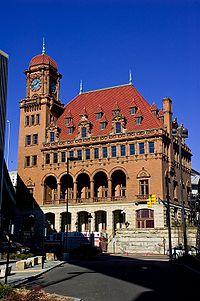
The Greater Richmond area is served by the Richmond International Airport (IATA: RIC, ICAO: KRIC), located in nearby Sandston, seven miles (11 km) southeast of Richmond and within an hour drive of historic Williamsburg, Virginia. Richmond International is now served by nine airlines with over 200 daily flights providing non-stop service to major destination markets and connecting flights to destinations worldwide. A record 3.3 million passengers used Richmond International Airport in 2006, a 13% increase over 2005.
Intercity bus service is provided by Greyhound Lines (with its terminal at 2910 N Boulevard), and starting December 15, 2010, discount carrier Megabus, with fares starting at $1. Direct service will be available to Washington, D.C., Hampton Roads, Charlotte, Raleigh, Baltimore, and Philadelphia. Most other connections to Megabus served cites, such as New York, can be made from Washington, D.C.[121]
Local transit and paratransit bus service in Richmond, Henrico, and Chesterfield counties is provided by the Greater Richmond Transit Company (GRTC). The GRTC, however, serves only small parts of the suburban counties. The far West End (Innsbrook and Short Pump) and almost all of Chesterfield County have no public transportation despite dense housing, retail, and office development. According to a 2008 GRTC operations analysis report, a majority of GRTC riders utilize their services because they do not have an available alternative such as a private vehicle.[122]
The Richmond area also has two railroad stations served by Amtrak. Each station receives regular service from north of Richmond from Washington, D.C., Philadelphia, and New York. The suburban Staples Mill Road Station is located on a major north-south freight line and receives all service to and from all points south including, Raleigh, Durham, Savannah, Newport News, Williamsburg and Florida. Richmond's only railway station located within the city limits, the historic Main Street Station, was renovated in 2004.[123] As of 2010, the station only receives trains headed to and from Newport News and Williamsburg due to track layout. As a result, the Staples Mill Road station receives more trains and serves more passengers overall.
Richmond also benefits from an excellent position in reference to the state's transportation network, lying at the junction of east-west Interstate 64 and north-south Interstate 95, two of the most heavily traveled highways in the state, as well as along several major rail lines. Other major highways passing through Richmond include U.S. Routes 1, 33, 60, 250, 301 and 360.
Electricity in the Richmond Metro area is provided by Dominion Virginia Power. The company, based in Richmond, is one of the nation's largest producers of energy, serving retail energy customers in nine states. Electricity is provided in the Richmond area primarily by the North Anna Nuclear Generating Station and Surry Nuclear Generating Station, as well as a coal-fired station in Chester, Virginia. These three plants provide a total of 4,453 megawatts of power. Several other natural gas plants provide extra power during times of peak demand. These include a facility in Chester, in Surry, and two plants in Richmond (Gravel Neck and Darbytown).[124]
Natural gas in the Richmond Metro area is provided by the city's Department of Public Utilities and also serves portions of Henrico and Chesterfield counties.
Water is provided by the city's Department of Public Utilities, and is one of the largest water producers in Virginia, with a modern plant that can treat up to 132 million gallons of water a day from the James River.[125] The facility also provides water to the surrounding area through wholesale contracts with Henrico, Chesterfield, and Hanover counties. Overall, this results in a facility that provides water for approximately 500,000 people.
The wastewater treatment plant and distribution system of water mains, pumping stations and storage facilities provide water to approximately 62,000 customers in the city. There is also a wastewater treatment plant located on the south bank of the James River. This plant can treat up to 70 million gallons of water per day of sanitary sewage and stormwater before returning it to the river. The wastewater utility also operates and maintains 1,500 miles (2,400 km) of sanitary sewer, pumping stations, 38 miles (61 km) of intercepting sewer lines, and the Shockoe Retention Basin, a 44-million-gallon stormwater reservoir used during heavy rains.
Richmond has seven sister cities, as designated by the Sister Cities International, Inc.:[126]
Word Count: 10481






